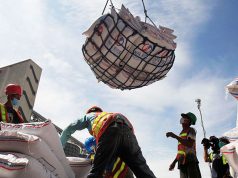By Marissa Mae M. Ramos
Researcher
EMPLOYMENT growth among large Metro Manila firms accelerated in the second quarter of 2019, the Philippine Statistics Authority (PSA) said.
In its Labor Turnover Survey, the PSA said labor turnover in the National Capital Region (NCR) was 1.1% in the second quarter, higher than the 0.5% logged a quarter earlier.
This means that for every 1,000 persons employed, large firms were hiring some 11 additional workers on a net basis during the second quarter.
The labor turnover rate is the difference between the rate of accession or hiring and the rate of separation or job termination or resignation.
The rate of accession — which represents hiring by employers to either replace former employees or expand their workforce — stood at 9.5% in the second quarter, up from 9.3% in the previous quarter.
The rate of separation — which covers termination and resignation — stood at 8.3%, down from the first quarter’s 8.8%.
More people were hired in the second quarter due to the replacement of former workers at 5.2%, compared to those who were hired due to business expansion at 4.3%.
Meanwhile, of the 8.3% separation rate, 5.5% was employee-initiated and 2.8% employer-initiated.
Being “hired by another company” and “family considerations” were the main reasons for employee-initiated separations, as cited by 37.4% and 19.9% of the respondents who left their employers of their own accord, respectively.
On the other hand, the main reasons for employers ending the services of their workers were “project completion” (38.2%) and “absence without leave or AWOL” (27.9%).
The services sector posted a net job creation rate of 1.4%, following an accession rate of 9.9% and separation rate of 8.5%.
Negative job creation rates were observed in agriculture, forestry and fishing (-0.2%) and industry (-0.1%) sectors. For agriculture, its separation rate of 4.2% outpaced its accession rate of four percent. Likewise, the industry sector’s 7.6% separation rate exceeded its accession rate of 7.5%.
Asked to comment, UnionBank of the Philippines, Inc. Chief Economist Ruben Carlo O. Asuncion said the Philippine labor market continues to be “tight” as characterized by low unemployment, upward pressure on wages, and a high turnover ratio.
“This higher labor turnover rate in the NCR (confirms the view that) the labor market (is) tight,” Mr. Asuncion said.
“Economic development also plays a key role and it can help play certain labor turnover dynamics. In NCR’s case, it would most likely be the upward pressure on wages and the considerable amount of job options for many of the labor force,” he added.
The PSA survey also showed 96,135 job vacancies in the second quarter, more than the 85,410 vacancies in the first quarter.
These vacancies were highest in the services sector, which accounted for 91.3% of the total, or 87,738 openings. The share of the industry sector was 8.4% (8,099) while that of agriculture, forestry and fishing was 0.3% (298).
By occupation group, employers mostly looked to fill in positions for service and sales workers (36.3% of job vacancies); clerical support workers (17.2%); professionals (16.4%); technicians and associate professionals (12.2%); and plant and machine operators and assemblers (5.9%).
The first- and second-quarter labor turnover surveys conducted by the PSA involved 2,466 establishments in Metro Manila. Sampled firms, each of which had at least 20 workers, were drawn from the 2018 NCR List of Establishments.
Moving forward, Mr. Asuncion said: “With current challenges posed by the Covid-19 health scare on the global economy and the interconnection of the Philippine economy to multinational companies that may be affected…the present labor market may be humming a different tune especially for 2020. At this point, it is hard to anticipate a certain outcome or change.”



